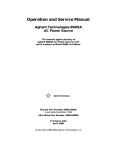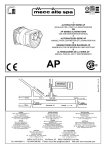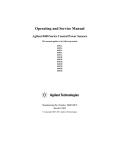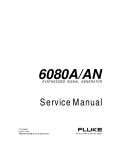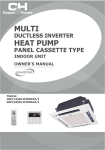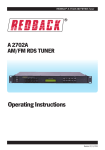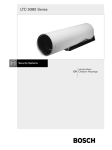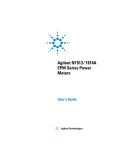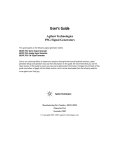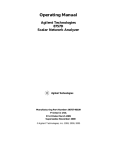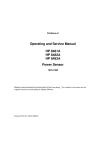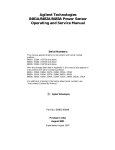Download Agilent R8486A and Q8486A Power Sensor
Transcript
Agilent R8486A and Q8486A Power Sensor Operating and Service Manual Agilent Technologies Notices © Agilent Technologies, Inc. 2006-2008, 2010 No part of this manual may be reproduced in any form or by any means (including electronic storage and retrieval or translation into a foreign language) without prior agreement and written consent from Agilent Technologies, Inc. as governed by United States and international copyright laws. Manual Part Number 08486-90026 Edition Fourth Edition, June 30, 2010 Printed in Malaysia Agilent Technologies, Inc. 3501 Stevens Creek Blvd. Santa Clara, CA 95052 USA Warranty Safety Notices The material contained in this document is provided “as is,” and is subject to being changed, without notice, in future editions. Further, to the maximum extent permitted by applicable law, Agilent disclaims all warranties, either express or implied, with regard to this manual and any information contained herein, including but not limited to the implied warranties of merchantability and fitness for a particular purpose. Agilent shall not be liable for errors or for incidental or consequential damages in connection with the furnishing, use, or performance of this document or of any information contained herein. Should Agilent and the user have a separate written agreement with warranty terms covering the material in this document that conflict with these terms, the warranty terms in the separate agreement shall control. Technology Licenses The hardware and/or software described in this document are furnished under a license and may be used or copied only in accordance with the terms of such license. Restricted Rights Legend U.S. Government Restricted Rights. Software and technical data rights granted to the federal government include only those rights customarily provided to end user customers. Agilent provides this customary commercial license in Software and technical data pursuant to FAR 12.211 (Technical Data) and 12.212 (Computer Software) and, for the Department of Defense, DFARS 252.227-7015 (Technical Data - Commercial Items) and DFARS 227.7202-3 (Rights in Commercial Computer Software or Computer Software Documentation). ii CAUTION A CAUTION notice denotes a hazard. It calls attention to an operating procedure, practice, or the like that, if not correctly performed or adhered to, could result in damage to the product or loss of important data. Do not proceed beyond a CAUTION notice until the indicated conditions are fully understood and met. WA R N I N G A WARNING notice denotes a hazard. It calls attention to an operating procedure, practice, or the like that, if not correctly performed or adhered to, could result in personal injury or death. Do not proceed beyond a WARNING notice until the indicated conditions are fully understood and met. R8486A/Q8486A Operating and Service Manual Certification Agilent Technologies certifies that this product met its published specifications at the time of shipment. Agilent further certifies that its calibration measurements are traceable to the United States National Institute of Standard and Technology (formerly National Bureau of Standards), to the extent allowed by that organization’s calibration facility, and to the calibration facilities of other International Standards Organization members. General Warranty The material contained in this document is provided “as is,” and is subject to being changed, without notice, in future editions. Further, to the maximum extent permitted by applicable law, Agilent disclaims all warranties, either express or implied with regard to this manual and any information contained herein, including but not limited to the implied warranties of merchantability and fitness for a particular purpose. Agilent shall not be liable for errors or for incidental or consequential damages in connection with the furnishing, use, or performance of this document or any information contained herein. Should Agilent and the user have a separate written agreement with warranty terms covering the material in this document that conflict with these terms, the warranty terms in the separate agreement shall control. Duration and conditions of warranty for this product may be superseded when the product is integrated into (becomes a part of) other Agilent products. During the warranty period, Agilent will, at its option, either repair or replace products which prove to be defective. The warranty period begins on the date of delivery or on the date of installation if installed by Agilent. Warranty Service For warranty service or repair, this product must be returned to a service facility designated by Agilent. For products returned to Agilent for warranty service, the Buyer shall prepay shipping charges to Agilent and Agilent shall pay shipping charges to return the product to the Buyer. However, the Buyer shall pay all shipping charges, duties, and taxes for products returned to Agilent from another country. R8486A/Q8486A Operating and Service Manual iii Limitation of Warranty The foregoing warranty shall not apply to defects resulting from improper or inadequate maintenance by the Buyer, Buyer-supplied products or interfacing, unauthorized modification or misuse, operation outside of the environmental specifications for the product, or improper site preparation or maintenance. The design and implementation of any circuit on this product is the sole responsibility of the Buyer. Agilent does not warrant the Buyer’s circuitry or malfunctions of Agilent products that result from the Buyer’s circuitry. In addition, Agilent does not warrant any damage that occurs as a result of the Buyer’s circuit or any defects that result from Buyer-supplied products. To the extent allowed by local law, Agilent makes no other warranty, expressed or implied, whether written or oral with respect to this product and specifically disclaims any implied warranty or condition of merchantability, fitness for a particular purpose or satisfactory quality. Exclusive Remedies To the extent allowed by local law, the remedies provided herein are the Buyer’s sole and exclusive remedies. Agilent shall not be liable for any direct, indirect, special, incidental, or consequential damages (including lost profit or data), whether based on warranty, contract, tort, or any other legal theory. iv R8486A/Q8486A Operating and Service Manual Restricted Rights Legend The Software and Documentation have been developed entirely at private expense. They are delivered and licensed as “commercial computer software” as defined in DFARS 252.227-7013 (Oct 1988), DFARS 252.211-7015 (May 1991), or DFARS 252.227-7014 (Jun 1995), as a “commercial item” as defined in FAR 2.101(a), or as “restricted computer software” as defined in FAR 52.227-19 (Jun 1987) (or any equivalent agency regulation or contract clause), whichever is applicable. You have only those rights provided for such Software and Documentation by the applicable FAR or DFARS clause or the Agilent standard software agreement for the product involved. Technology Licenses The hardware and/or software described in this document are furnished under a license and may be used or copied only in accordance with the terms of such license. R8486A/Q8486A Operating and Service Manual v Safety Summary The following general safety precautions must be observed during all phases of operation of this instrument. Failure to comply with these precautions or with specific warnings elsewhere in this manual violates safety standards of design, manufacture, and intended use of the instrument. Agilent Technologies, Inc. assumes no liability for the customer’s failure to comply with these requirements. Safety Notices WA R N I N G CAUTION vi A WARNING notice denotes a hazard. It calls attention to an operating procedure, practice, or the like that, if not correctly performed or adhered to, could result in personal injury or loss of life. Do not proceed beyond a WARNING notice until the indicated conditions are fully understood and met. A CAUTION notice denotes a hazard. It calls attention to an operating procedure, practice, or the like that, if not correctly performed or adhered to, could result in damage to the product or loss of important data. Do not proceed beyond a CAUTION notice until the indicated conditions are fully understood and met. R8486A/Q8486A Operating and Service Manual Safety Symbols The following symbol on the instrument and in the documentation indicates precautions that must be taken to maintain safe operation of the instrument. Caution, risk of danger. The Instruction Documentation Symbol. The product is marked with this symbol when it is necessary for the user to refer to the instructions in the supplied documentation. Alternating current (AC). This symbol indicates the operating switch for ‘Stand-by’ mode. Note, the instrument is NOT isolated from the mains when the switch is pressed. To isolate the instrument, the mains coupler (mains input cord) should be removed from the power supply. Direct current (DC). Both direct and alternating current. Three-phase alternating current. Earth (ground) TERMINAL. R8486A/Q8486A Operating and Service Manual vii PROTECTIVE CONDUCTOR TERMINAL. Frame or chassis TERMINAL. Equipotentiality. On (Supply). Off (Supply). Equipment protected throughout by DOUBLE INSULATION or REINFORCED INSULATION. Caution, risk of electric shock. Caution, hot surface. In position of bi-stable push control. viii R8486A/Q8486A Operating and Service Manual Out position of bi-stable push control. R8486A/Q8486A Operating and Service Manual ix General Safety Information The following general safety precautions must be observed during all phases of operation, service, and repair of this instrument. Failure to comply with these precautions or with specific warnings elsewhere in this manual violates safety standards of design, manufacture, and intended use of the instrument. Agilent Technologies assumes no liability for the customer’s failure to comply with these requirements. WA R N I N G CAUTION x BEFORE CONNECTING THE POWER SENSOR TO OTHER INSTRUMENTS, ensure that all instruments are connected to the protective (earth) ground. Any interruption of the protective earth grounding will cause a potential shock hazard that could result in personal injury. • Use the device with the cables provided. • Repair or service that is not covered in this manual should only be performed by qualified personnels. R8486A/Q8486A Operating and Service Manual In This Guide ... 1 Product Outlook Chapter 1 contains information about initial inspection, performance tests, adjustments, operation, troubleshooting and repair of the AG R8486A and AG Q8486A power sensors. 2 Operation Chapter 2 provides the information on the operating procedures of your AG R8486A and AG Q8486A power sensors. 3 Specifications Chapter 3 describes the specifications for the AG R8486A and AG Q8486A power sensors. 4 Service Chapter 4 explains the service, performance tests, replaceable parts and troubleshooting for your AG R8486A and AG Q8486A power sensors. R8486A/Q8486A Operating and Service Manual xi xii R8486A/Q8486A Operating and Service Manual Contents Contents 1 Product Outlook 1 General Information 2 Description 2 Figure 1-1AG R8486A and AG Q8486A power sensors Installation 4 Initial Inspection 4 Interconnections 4 Storage and Shipment 3 5 2 Operation 7 Operation 8 Figure 2-2Q–Band Power Sensor to Waveguide Connection 10 Table 2-1. Cal Factor % to dB Conversion 11 3 Specifications 13 Specifications 14 Table 3-2. Specifications 14 Calibration Factor (CF) and Reflection Coefficient (Rho) 15 Table 3-3. Power Sensor Uncertainty of Calibration Factor Data 16 4 Service 17 Recommended Test Equipment 18 Table 4-4. Recommended Test Equipment Performance Tests and Adjustments 19 SWR (Reflection Coefficient) Test 19 Replaceable Parts 23 Table 4-5. Code List of Manufacturers Table 4-6. Replaceable Parts 24 Figure 4-3Illustrated Parts Breakdown 18 23 28 Service 29 Principles of Operation 29 Figure 4-4Component and Assembly Locations Agilent U1251A/U1252A User’s and Service Guide 31 xiii Contents Figure 4-5Power Sensor Schematic Component and Assembly Locations 32 Troubleshooting 33 Figure 4-6Operational Amplifier 34 Repair 36 Figure 4-7Removing Power Sensor Shell 38 Figure 4-8Power Sensor Hardware Locations 41 Manual Changes 42 Introduction 42 How to Use Manual Changes 42 Table 4-7. Manual Changes by Serial Prefix or Number Figure 4-9AG R8486A (2503A) and AG Q8486A (2702A, 2503A) Component Locations 43 42 NOTICE 44 WARRANTY 44 Herstellerbescheinigung 44 Manufacturer’s Declaration 45 xiv Agilent U1251A/U1252A User’s and Service Guide Agilent R8486A and Q8486A Power Sensor Operating and Service Manual 1 Product Outlook General Information Installation 4 2 Agilent Technologies 1 1 Introduction General Information This Operating and Service Manual contains information about initial inspection, performance tests, adjustments, operation, troubleshooting and repair of the AG R8486A and AG Q8486A power sensors. Description The AG R8486A and AG Q8486A are thermocouple power sensors. They measure power levels in a range from –30 dBm to +20 dBm (1 μW to 100 mW). The AG R8486A measures at frequencies from 26.5 GHz to 40 GHz. The AG Q8486A measures at frequencies from 33 GHz to 50 GHz. 2 R8486A/Q8486A Operating and Service Manual Introduction 1 Figure 1-1 AG R8486A and AG Q8486A power sensors R8486A/Q8486A Operating and Service Manual 3 1 Introduction Installation Initial Inspection Inspect the shipping container for damage. If the shipping container or packaging material is damaged, it should be kept until the contents of the shipment have been checked mechanically and electrically. If there is mechanical damage or if the instrument does not pass the performance test, notify the nearest Agilent Technologies office. Keep the damaged shipping materials (if any) for inspection by the carrier and an Agilent Technologies representative. Interconnections The AG R8486A and AG Q8486A power sensors have two inputs: a Type–N connector for a 50 MHz 1 mW calibration signal generated by the power meter, and a waveguide flange to connect to the device under test. Refer to the power meter operating and service manual for interconnecting instructions. CAUTION 4 Connect the power sensors by turning only the nut on the Type–N connector. Damage can occur if torque is applied to the power sensors body. R8486A/Q8486A Operating and Service Manual Introduction 1 Storage and Shipment Environment The instruments should be stored in a clean, dry environment. The following limitations apply to both storage and shipment: Temperature –55 to + 75 °C Relative Humidity less than 95% at 40 °C Altitude less than 15,300 meters (50,000 feet) Original Packaging Containers and materials identical to those used in factory packaging are available through Agilent Technologies offices. If the instrument is being returned to Agilent Technologies for servicing, attach a tag indicating the type of service required, return address, model number, and serial number. Also, mark the container FRAGILE to assure careful handling. In any correspondence, refer to the instrument by model number and serial number. R8486A/Q8486A Operating and Service Manual 5 1 6 Introduction R8486A/Q8486A Operating and Service Manual Agilent R8486A and Q8486A Power Sensor Operating and Service Manual 2 Operation Operation 8 Agilent Technologies 7 2 General Power Meter Functions Operation WA R N I N G BEFORE CONNECTING THE POWER SENSOR TO OTHER INSTRUMENTS ensure that all instruments are connected to the protective (earth) ground. Any interruption of the protective earth grounding will cause a potential shock hazard that could result in personal injury. Operating Environment The operation environment for the power sensors should be within the following limits: 8 Temperature: 0 to +55 °C Relative Humidity: less than 95% at 40 °C Altitude: less than 4550 meters (15,000 feet) R8486A/Q8486A Operating and Service Manual General Power Meter Functions 2 Operating Precautions CAUTION If the following energy and power levels are exceeded, the power meter system may be damaged. • Maximum Average Power: 300 mW • Maximum Peak Power: 15 W • Maximum Energy Per Pulse: 30 W.µs Use the plastic flange cover to protect the waveguide connector from dirt and mechanical damage whenever it is not in use. Any burrs, dents or dirt on the flange or waveguide surface will increase the SWR. The Type–N connector plastic bead deteriorates when contacted by any chlorinated or aromatic hydrocarbons such as acetone, trichlor, carbon tetrachloride, benzene, etc. Clean the connector face with a cotton swab saturated in isopropyl alcohol. For Q8486A only, damage may occur to the precision waveguide flange if the following procedure is not followed: 1 Torque the waveguide flange screws to no more than 60 inch-ounces (0.42 N.m) maximum. 2 Insert the two screws, indicated in Table 2-1, from the power sensor side of the flange. The other two screws can be inserted from either side of the flange. Tighten the four screws until just finger tight. 3 Using a calibrated torque wrench, tighten the flange by going back and forth between screws that are opposite each other, tightening each screw by small increments until reaching the desired torque. If using the hex ball driver, hold between thumb and forefinger to avoid excess torque. Do not fully torque one screw before tightening the other. Using extreme care not to over–torque when using the hex ball driver. R8486A/Q8486A Operating and Service Manual 9 2 General Power Meter Functions Insert this screw, and the one opposite (hidden under instrument), as shown. Figure 2-2 Q–Band Power Sensor to Waveguide Connection Power Meter Calibrations AG R8486A and Q8486A power sensors have a reference calibration factor of 100%. Calibrate your power meter and power sensor according to directions given in the power meter manual. Power Measurements To correct for varying thermocouple responses at different frequencies a cal factor chart is included on the power sensors. To use the cal factor at the frequency of interest, adjust the power meter's CAL FACTOR control according to the instructions in the power meter's operating and service manual. Note that in some cases, there may be a cal factor value of less than 85% listed in the sensor. When using the sensor with the AG 438A power meter, merely enter the cal factor value. If an AG 435B or 436A power meter is being used, set the cal factor control to 100%, and divide the reading in watts units (milliwatts or microwatts) by the decimal equivalent of the cal factor. For example, if the cal factor is 75%, divide the reading by 0.75. (This will result in a larger value of power than that displayed by the meter.) 10 R8486A/Q8486A Operating and Service Manual General Power Meter Functions 2 If reading in dBm, use the chart in Table 2- 1 to convert the cal factor to dB and add this value to the reading. Interpolate for values between those shown. As above, the cal factor control should be set to 100%. For example, if the cal factor is 75%, add 1.25 dB to the displayed value. The above procedure has eliminated some mathematical steps, the following formula may be of some use: Correction dB = Reading dB – 10 log10 Cal Factor (decimal). Table 2-1 Cal Factor % to dB Conversion Cal Factor dB Cal Factor dB Cal Factor dB 50% 3.01 62% 2.08 74% 1.31 51% 2.92 63% 2.01 75% 1.25 52% 2.84 64% 1.94 76% 1.19 53% 2.76 65% 1.87 77% 1.14 54% 2.68 66% 1.80 78% 1.08 55% 2.60 67% 1.74 79% 1.02 56% 2.52 68% 1.67 80% 0.97 57% 2.44 69% 1.61 81% 0.92 58% 2.37 70% 1.55 82% 0.86 59% 2.29 71% 1.49 83% 0.81 60% 2.22 72% 1.43 84% 0.76 61% 2.15 73% 1.37 85% 0.71 Operating Instructions To operate the Power Sensor, refer to the operating instructions in Section III of the power meter operating and service manual. Note, under power meter calibrations above, that each power meter requires a different calibration procedure. R8486A/Q8486A Operating and Service Manual 11 2 General Power Meter Functions Modulation Effects When measuring microwave sources that are modulated at the chopper frequency (nominally 220 Hz), or at the first or second harmonic or submultiples of the chopper frequency, beat notes will occur. Unless these beat notes are exactly the chopper frequency, they can usually be eliminated by averaging since the amplitudes are plus and minus the actual power. These frequencies may also be avoided by changing the modulation frequency slightly, if possible. If an AG 438A is being used, select a manual filter setting of greater than 3 to minimize beat note interference. 12 R8486A/Q8486A Operating and Service Manual Agilent R8486A and Q8486A Power Sensor Operating and Service Manual 3 Specifications Specifications 14 Agilent Technologies 13 3 Using P-Series Power Sensor Specifications (Specifications for the power sensors are in Table 3-2) The power sensors contain two thermocouples (with two thin- film resistors) on a silicon chip. The thermal/mechanical layout of the thermocouple is selected to give a hot junction at the resistor (center of the chip) and a cold junction at the outer edge of the chip. Table 3-2 Specifications Frequency Range: AG R8486A: 26.5 GHz to 40 GHz AG Q8486A: 33 GHz to 50 GHz Power Range: –30 dBm to +20 dBm (1 µW to 100 mW) Nominal Impedance: 50 Ω Maximum SWR AG R8486A: 1.4 (0.167) (Reflection Coefficient): AG Q8486A: 1.5 (0.200) 50 MHz Calibration Port SWR1: < 1.15 (0.070) Waveguide Flange: AG R8486A: UG-599/U2 AG Q8486A: UG-383/U Maximum Power: 300 mW Average3 Maximum Peak Power: 15 W Maximum Energy/Pulse 30 W.µs Operating Temperature: 0 to +55 ºC Worst case Power Linearity4: +2% to –4% 10 mW to 100 mW 1 Coaxial connector for 50 Mhz calibration is Type–N male. 2 Rectangular cover flange for circular cover flange, use AG 11516A Adapter. 3 For pulses greater than 30 W the maximum average power (P) is limited by the energy per pulse (E) in W.ms according to P = 30 – 0.02E 4 Negligible deviation except for those power ranges noted. 14 R8486A/Q8486A Operating and Service Manual Using P-Series Power Sensor 3 When the resistor at the hot junction converts the applied microwave energy to heat, the temperature difference between the hot and cold junctions generates a dc voltage (thermoelectric emf). The dc voltage is proportional to the temperature difference between the junctions and, therefore, proportional to the power from the microwave source. The dc voltage thus generated is a very low–level voltage (approximately 160 nV for 1 μW applied power) and requires amplification before it can be transferred on standard cables. The amplification is provided by an input amplifier assembly which consists a chopper (sampling gate) and an input amplifier. The dc voltage is routed on gold wires to the chopper circuit which converts the low–level dc voltage to an ac voltage. To do this, the chopper uses two field effect transistors (FETs) controlled by a 220 Hz square wave generated by the power meter. The result is an ac output signal proportional to the dc input. The ac signal is then amplified by the input amplifier. The relatively high–level ac signal output can now be routed by standard cables. In application, the power sensors are connected between a microwave source and a compatible power meter. (Suitable meters are the AG 435B, AG 436A, AG 437B and AG 438A.) The power sensors provide a matched load for the microwave source. This load is determined by the thermocouples which are each 100 ohms and are in parallel to the internal microwave coaxial lines. The very low SWR to 40 or 50 GHz is possible because of the low parasitics of the thermocouple chip and the multi–stepped coax–to–waveguide transition (which adapts the 50 ohm thermocouple impedance to the desired waveguide impedance). The power meter indicates the power dissipated in these thermocouples in μW (or mW) or in dBm. Calibration Factor (CF) and Reflection Coefficient (Rho) CAL FACTOR and reflection coefficient data are provided on a label attached to the cover. Maximum uncertainties of the CAL FACTOR data are listed in Table 3- 2. The CAL FACTOR compensates for the frequency response of the sensors. R8486A/Q8486A Operating and Service Manual 15 3 Using P-Series Power Sensor Table 3-3 Power Sensor Uncertainty of Calibration Factor Data Uncertainty of AG R8486A Calibration Factor at 1 mW Uncertainty of AG Q8486A Calibration Factor at 1 mW Frequency (Ghz) Worse Case Uncertainty (%) Probable Uncertainty (%) Frequency (Ghz) Worse Case Uncertainty (%) Probable Uncertainty (%) 26.5 6.10 3.08 33 7.85 4.03 27 6.72 3.15 34.5 7.84 4.03 28 6.76 3.19 35 8.39 4.06 29 6.20 3.17 36 7.69 3.99 30 6.75 3.18 37 7.70 3.99 31 6.10 3.08 38 8.34 4.05 32 6.67 3.13 39 8.37 4.06 33 6.05 3.06 40 7.80 4.02 34 6.64 3.12 41 9.33 4.42 34.5 6.04 3.06 42 10.25 4.78 35 6.59 3.10 43 10.98 5.11 36 5.89 3.02 44 11.10 5.41 37 5.90 3.02 45 12.27 5.71 38 6.53 3.09 46 12.84 5.97 39 6.56 3.1 47 12.50 6.17 40 6.00 3.06 48 12.8 6.03 49 12.30 5.84 50 11.00 5.59 Reflection Coefficient (Rho — or ρ) relates to SWR according to the following formula: SWR = (1 + ρ/1 – ρ) 16 R8486A/Q8486A Operating and Service Manual Agilent R8486A and Q8486A Power Sensor Operating and Service Manual 4 Service Recommended Test Equipment 18 Performance Tests and Adjustments 19 Agilent Technologies 17 4 CCDF Recommended Test Equipment Table 4-4 lists the test equipment recommended to check, adjust, and troubleshoot the power sensors. If substitute equipment is used, it must meet or exceed the critical specifications. Table 4-4 Recommended Test Equipment1 Instrument Digital Voltmeter Critical Specifications Recommended Model Use*2 Range 100 mW Vdc AG 3478A T AG 54200A A, T AG 10004D A AG 3478A A, T Input impedance: 10 megohms Resolution: 4–digit Accuracy: ±0.05% ± 1 digit Oscilloscope Bandwidth: dc to 50 MHz Sensitivity: Vertical, 0.2 V/div Sensitivity: Horizontal, 1 ms/div 10 : 1 Divider Probe 10 megohms 10 pF Multimeter Range: 1 ohm to 100, 000 ohms 20 mV, full scale Accuracy: ±5% DC Power Supply Range: 0 to 20 Vdc AG 6200B T Power Meter Availability of test point after 3rd amplifier and prior to phase detector. AG 435B A 1 Equipment for an SWR test is not listed here because there are several different techniques for measuring SWR. However, some suggestions for test equipment are made in the instructions for the SWR test. 2 A = Adjustments T= Troubleshooting 18 R8486A/Q8486A Operating and Service Manual CCDF 4 Performance Tests and Adjustments SWR (Reflection Coefficient) Test This section does not establish preset SWR test procedures since there are several test methods and different equipment available for testing the SWR or reflection coefficient. Therefore, the actual accuracy of the test equipment must be taken into account when measuring against instruments specifications to determine a pass or fail condition. To measure the SWR across the waveguide band, use a directional coupler and detector selected for the band of interest. The directional coupler should have a directivity greater than 37dB. The detector should have greater than 0.3 mV/mW sensitivity and should be calibrated with a rotary vane attenuator with an accuracy of 2%. A convenient source is a frequency tripler driven by an AG 8350B and an AG 83594A. An AG 8349A can also be used as a source if the tripler can handle 100 mW of input power. CAUTION Some frequency triplers are very delicate and are close to burn out at 100 mW. We suggest 3 dB of attenuation to start, and a high pass filter, (such as a pair of AG P281C adaptors back to back) because the AG 83594A can be capable of greater than 150 mW at low frequencies and will damage the tripler. To check the calibration factor, the power sensors should be compared with another recently calibrated power sensor. The source should be leveled with a reference coupler that has low SWR and high directivity to monitor or level the incident power. For reflection measurements we suggest Agilent Application Note 183 ''High Frequency Swept Measurements''. For calibration factor and error analysis we suggest Agilent Application Note 64–1 ''Fundamentals of RF and Microwave Power Measurements''. R8486A/Q8486A Operating and Service Manual 19 4 CCDF NOTE While the flange of the AG R8486A is similar to the one described in MIL F–3922/54C–003, the AG Q8486A has been modified to mate with greater precision to MIL–3922/67B–006 flanges. The true position of the holes relative to each other are held to a diameter tolerance of 0.0254 mm (0.001''). The holes are held to 1.664 mm (0.0655'') minimum diameter while the pins are held to 1.61 mm (0.0634'') maximum diameter. FET Balance Adjustment WA R N I N G The following procedure exposes high voltage areas within the power meter. Use extreme care while working around these areas or personal injury could occur. Equipment Oscilloscope: AG 54200A Power Meter: AG 435B Multimeter: AG 3478A The sampling gate balance is affected by the relative positions of the wires in the power sensors, which connect to pins G and H of connector J1. One wire is black and white; the other is brown and white. Moving the black and white wire will adjust the switching transient amplitude (spike). Moving the brown and white wire will change the offset. Once positioned, be careful not to displace these wires. To correctly position these wires, after replacement of A2U1, or if the wires have been moved so as to affect the sampling gate balance, perform the following procedure. NOTE 20 If the power sensor printed circuit board A2 has been removed for repair, make sure all surfaces are thoroughly clean and free of flux residues before attempting the following adjustments. R8486A/Q8486A Operating and Service Manual CCDF 4 1 Set the multimeter controls as follows: FUNCTION: Voltage Range: 20 mV, full scale 2 Set oscilloscope controls as follows: SENSITIVITY: 0.2V/DIV SWEEP: 1 ms/DIV TRIGGER: INT+ Display: A 3 Set the power meter CAL FACTOR to 100%. Set the power meter RANGE to 1 mW (0 dBm). 4 Open the power sensor (see Disassembly Procedure, Steps 1 through 3). Zero and calibrate the power meter. Leave the opened power sensor connected to the power meter POWER REF output. Heat can affect the adjustments so handle the sensor as little as possible. 5 Turn OFF the POWER REF switch on the rear panel of the power meter. 6 Remove the AG 435B bottom panel. This will expose the circuit side of the A5 printed circuit board. On A5 you will see a long double row of soldered terminals numbered 1 to 44. 7 Connect a probe from pin 40 (the number 902 is printed on the board next to pin 40) to the multimeter input. 8 Lay the AG 435B on its left side and remove the right panel. This will expose the A4 assembly. 9 Connect a 1:1 probe from TP4 to channel A on the oscilloscope. 10 Offset. Read the multimeter and adjust the position of the brown and white wire until the reading is between –7.0 mV and –2.0 mV. Helpful hint: the relative position of the brown and white wire to C4 will adjust the offset. 11 Switching transients. Read the oscilloscope and adjust the position of the black and white wire until the switching transients are less than 0.8V peak R8486A/Q8486A Operating and Service Manual 21 4 CCDF to peak. Helpful hint: the relative position of the black and white wire to the collector of Q1 will adjust the switching transients. 12 You will find that positioning the wire for switching transients affects the offset. Go back and forth between the two wires, positioning and repositioning, until both adjustments are within specifications. 22 R8486A/Q8486A Operating and Service Manual CCDF 4 Replaceable Parts Table 4-6 is a list of replaceable parts. Figure 4-3 is the illustrated parts breakdown (IPB) that identifies the major assemblies and chassis parts. The mounting locations of the components on the A2 Input Amplifier Assembly are shown in Figure 4-4. To order a part, quote the Agilent part no and Check Digit (CD), specify the quantity required, and address the order to the nearest Agilent Technologies office (see NOTE below). To order a part not listed in Table 4-5, give the instrument model number, instrument serial number, the description and function of the part, and the quantity of parts required. NOTE Within the USA, it is better to order directly from the Agilent Parts Center in Mt. View, California. Ask your nearest Agilent Technologies office for information and forms for the ''Direct Mail Order System'' Table 4-5 Code List of Manufacturers Mfr Code Manufacturer Name Address Zip Code 00000 ANY SATISFACTORY SUPPLIER 00843 HOFFMAN ENG CO DIV OF FED CARTRIDGE ANOKA MN 55303 01640 MULTIMATIC PRODUCTS INC HAUPPAUGE NY US 11788 01686 RCL ELECTRONICS INC NORTHBROOK IL US 60062 01766 INTL CRYSTAL MFG CO INC OKLAHOMA CITY OK 73102 05876 U S POLYMERIC INC STAMFORD CT 06904 06383 PANDUIT CORP TINLEY PARK IL US 60477 09969 DALE ELECTRONICS INC YANKTON SD US 57078 11045 AM CASTLE & CO INC FRANKLIN PARK IL US 60131 11502 IRC INC BOONE NC US 28607 12344 TALLY CORP KENT WA 98031 12498 CRYSTALONICS DIV TELEDYNE CAMBRIDGE MA 02140 24931 SPECIALTY CONNECTOR CO FRANKLIN IN US 46131 R8486A/Q8486A Operating and Service Manual 23 4 CCDF Table 4-5 Code List of Manufacturers (continued) Mfr Code Manufacturer Name Address Zip Code 28480 AGILENT TECHNOLOGIES CO CORPORATE HQ PALO ALTO 94304 84830 LEE SPRING CO BROOKLYN NY US 11219 Table 4-6 Replaceable Parts Reference Designation Agilent Part Number CD Qty Description Mfr Code Manufacturer Part Number A1 08486–60001 5 1 BULKHEAD AY R 28480 08486–60001 A1 08486–60002 6 1 BULKHEAD AY Q 28480 08486–60002 A2 08481–60025 8 1 POWER SENSOR BOARD ASSEMBLY 28480 08481–60025 A2C1 0180–2515 8 2 CAPACITORêFXD 47F ± 20% 6 VDC TA 12344 T355F476M006AS A2C2 0160–4306 7 4 CAPACITOR–FXD 100PF ± 10% 100 VDC CER 00843 0805C101K3P A2C3 0160–4306 7 – CAPACITOR–FXD 100PF ± 10% 6 VDC TA 00843 0805C101K3P A2C4 0180–0594 9 1 CAPACITOR–FXD 3.3UF ± 20% 15 VDC TA 12344 T350A335M016AS A2C5 0160–3094 8 1 CAPACITOR–FXD .1UF ± 10% 100 VDC CER 06383 FD22X5R2A104K A2C6 0160–3879 7 1 CAPACITOR–FXD .01UF ± 20% 100 VDC CER 09969 RPE121–105X7R10 3M100V A2C7 0160–4306 7 – CAPACITOR–FXD 100PF ± 10% 100 VDC CER 00843 0805C101K3P A2C8 0160–4306 7 – CAPACITOR–FXD 100PF ± 10% 100 VDC CER 00843 0805C101K3P AC29 0180–2515 8 CAPACITOR–FXD 47UF ± 20% 6 VDC TA 12344 T355F476M0Q6AS 24 R8486A/Q8486A Operating and Service Manual CCDF 4 Table 4-6 Replaceable Parts (continued) Reference Designation Agilent Part Number CD Qty Description Mfr Code Manufacturer Part Number A2C10 0180–2545 4 1 CAPACITOR–FXD 100UF ± 20% 4 VDC TA 01766 202l6301–107–M6–5 52 A2Q1 1854–0610 0 1 TRANSISTOR NPN SI TO–46 FT = 800 MHZ 28480 1854–0610 A2R1 0698–3260 9 1 RESISTOR 464K ± 1% .125W TF TC = 0 ± 100 12498 CT4 A2R2 0698–7428 1 1 RESISTOR 3.16K ± 1% .05W TF TC = 0 ± 100 12498 C3–1/8–TO–3161–F A2R3 0698–7224 3 1 RESISTOR 1K ± 1% .05W TF TC = 0 ± 100 12498 C3–1/8–TO–316R–F A2R4 0698–7236 7 1 RESISTOR 316 ± 1% .05W TF TC = 0 ± 100 12498 C3–1/8–TO–1001–F A2R5 0811–3210 1 1 RESISTOR 31.6 ± 5% .05W PN TC = 5040 ± 250 01686 R342 A2U1 1813–0060 8 1 IC MISC TO–8 PKG 28480 1813–0060 ACCESSORIES 1390–0671 9 1 Q FLANGE SCREW 4–40 THD; .312IN 28480 1390–0671 1401–0211 8 1 Q FLANGE COVER 11502 030–302 (WR 22) 2260–0002 6 6 R FLANGE NUT 4–40–THD .062–IN–THK 00000 ORDER BY DESCRIPTION 3030–0209 9 6 R FLANGE SCREW 4–40 .5–IN–LG ALY STL 00000 ORDER BY DESCRIPTION 5040–0359 3 1 R FLANGE COVER 28480 5040–0359 8710–1539 7 1 BALLDRIVER–HEX 11045 #A25 CHASSIS PARTS] J1 08481–60024 7 1 CONNECTOR ASSEMBLY–12 PIN 28480 08481–60024 MP1 08481–40002 9 2 SHELL–PLASTIC 28480 08481–40002 R8486A/Q8486A Operating and Service Manual 25 4 CCDF Table 4-6 Replaceable Parts (continued) Reference Designation Agilent Part Number CD Qty Description Mfr Code Manufacturer Part Number MP2 08481–40002 9 – SHELL PLASTIC 28480 08481–40002 MP3 08481–20011 8 2 CHASSIS 28480 08481–20011 MP4 08481–20011 8 – CHASSIS 28480 08481–20011 MP5 08481–20008 3 1 END BELL 28480 08481–20008 MP6 1460–4306 9 1 SPRING–CPRSN .88–IN–OA–LG 84830 C1–0088–2–SS MP7 1251–3363 8 1 NUT–AUDIO CONN 05876 91–T–1335–6–9 MP8 08481–00002 5 2 SHIELD 28480 08481–00002 MP9 08481–00002 5 – SHIELD 28480 08481–00002 MP10–MP18 3030–0954 1 9 SCREW–SKT HD CAP 0–80 .188–IN–LG SST–304 00000 ORDER BY DESCRIPTION MP19–MP22 3030–0422 8 4 SCREW–SKT HD CAP 0–80 .188–IN–LG SST–302 00000 ORDER BY DESCRIPTION MP23 3030–0436 4 1 SCREW–SKT HD CAP 0–80 .5–IN–LG SST–300 00000 ORDER BY DESCRIPTION MP24 5040–6939 7 1 CLAMP 28480 5040–6939 MP25 5040–6940 0 1 BLOCK 01640 5040–6940 MP26 08486–80003 9 1 LABEL–MODEL Q 28480 08486–80003 MP26 08486–80004 0 1 LABEL–MODEL R 28480 08486–80004 MP27 08486–80005 1 1 LABEL INFO (SIDE) 28480 08486–80005 MP28 1250–0016 0 1 COMPONENT–RF CONNECTORE SERIES N; .75 IN 24931 R100–1 MP29 1250–0916 9 1 BODY–RF CONNECTOR Series APC–N; STRAIGHT 01640 1250–0916 MP30 1250–0918 1 1 COMPONENT–RF CONNECTOR SERIES APC–N; SST 01640 1250–9016 MP31 08486–80006 2 1 CAL–LABEL (BLANK) 26 R8486A/Q8486A Operating and Service Manual CCDF 4 Table 4-6 Replaceable Parts (continued) Reference Designation Agilent Part Number CD Qty Description MP32 08481–80005 6 1 MYLAR TAPE (COVERS CAL LABEL) MP33 7120–2422 7 1 LABEL WARNING (SIDE) R8486A/Q8486A Operating and Service Manual Mfr Code Manufacturer Part Number 27 4 CCDF Figure 4-3 Illustrated Parts Breakdown 28 R8486A/Q8486A Operating and Service Manual CCDF 4 Service Service instructions consist of principles of operation, troubleshooting, and repairs. Test equipment which meets or exceeds the critical specifications in Table 4-4 may be used in place of the recommended instruments for troubleshooting the power sensor. Principles of Operation For the following discussion, refer to the schematic diagram in Figure 4-5 and the simplified diagram of the operational amplifier in Figure 4-6. The operational amplifier is made up of the power sensor input amplifier, A2Q1, and the first amplifier stage in the power meter. The A1 Bulkhead Assembly provides a low SWR load into both the waveguide input and the Type–N connector. The waveguide is terminated through a waveguide–to–coax adapter into a coaxial thermocouple. The adapter is shorted at the calibration input through a choke assembly to block microwave frequencies fed into the waveguide. However, the adaptor will still allow 50 MHz to be applied through the type- N connector for calibration purposes. This allows the power sensors to be conveniently adjusted for sensitivity changes caused by aging, variations in temperature, and inadvertent overloads. The RF signal is absorbed by the thermocouples which generate a dc voltage proportional to the RF input power. The dc voltage is routed from the thermocouples to the input amplifier on gold wires to reduce undesired thermocouple effects. The gold wires pass through ferrite beads A2E1 and A2E2 which are located in the black plastic book. (See Figure 4-5.) The ferrite beads increase the self–inductance of the gold wires causing this portion of the wires to provide the properties of an RF choke. The result is to minimize RF feedthrough to the A2 Input Amplifier Assembly. The dc output from the bulkhead assembly is applied to the two field effect transistors (FETs) in A2U1. These transistors function as a sampling gate or chopper. The sampling rate is controlled by a 220 Hz square wave supplied by the power. The amplitude of the sampling gate output (at pin 3 of A2U1) is a 220 Hz square wave proportional to the power input. The sampled 220 Hz ac output is applied to the input amplifier A2Q1 which is the input stage for an operational amplifier (Figure 4-5). The ac gain of the operational amplifier is approximately 700. R8486A/Q8486A Operating and Service Manual 29 4 CCDF A dc feedback voltage from the power meter Auto Zero circuit is coupled to the input od FET A2U1Q1 to set the zero level. The voltage is developed across the voltage divider consisting of A2R1 and the series resistance of the thermocouple A1TC1.When the power sensor is used with the AG 436A or AG 438A Power Meter, the short to ground at J1–K (Mount Resistor) causes the power meter to automatically select the proper measurement range of –30 to +20 dBm. 30 R8486A/Q8486A Operating and Service Manual CCDF 4 Figure 4-4 Component and Assembly Locations R8486A/Q8486A Operating and Service Manual 31 4 CCDF Figure 4-5 Power Sensor Schematic Component and Assembly Locations 32 R8486A/Q8486A Operating and Service Manual CCDF 4 Troubleshooting The troubleshooting information is intended to isolate a problem to a stage. The defective component can then be identified by voltage and resistance checks. The FETs in A2U1 are light sensitive and dc levels are shifted slightly when the FETs are exposed. CAUTION Excessive power will damage the thermocouples and cause their resistance to increase. When the microwave input power is 100mW, the bulkhead assembly generates +12 ± 3 mV. This voltage is measured at A2U1 pin 1. The voltage changes if the input amplifier is inoperative, or if the bulkhead assembly is disconnected from the input amplifier. Resistance measured across the two gold wires from the A1 assembly should be 200 ± 10 ohms. CAUTION Be extremely careful when measuring across the gold wires. They are delicate and can be damaged easily. R8486A/Q8486A Operating and Service Manual 33 4 CCDF Figure 4-6 Operational Amplifier NOTE 34 If the A1 Bulkhead Assembly is defective, the entire assembly must be replaced. R8486A/Q8486A Operating and Service Manual CCDF 4 FET Testing Check FETs in A2U1 using the following procedure: a Disconnect cables from power sensor. b Remove upper chassis from power sensor. (Refer to “Disassembly Procedure”). c Measure resistance between pins 1 and 2 of A2U1. Resistance should be 15 ± 0.75 ohms. Measure the same resistance between pins 8 and 9 of A2U1. d Short pins 4, 6, and 9 of A2U1 together. Measure resistance between pins 2 and 3, and between pins 3 and 8 of A2U1. Resistance should be less than 40 ohms. e Remove short. f Set a power supply to 10 Vdc. g Connect positive side of power supply to power sensor signal ground. Connect negative power supply lead to pins 4 and 6 of A2U1. h Measure resistance between pins 2 and 3 of A2U1 and between pins 3 and 8. In both cases, resistance should be several hundred times resistance measured in step d. Testing 220 Hz Drive. To ensure the 220 Hz drive is correct, check the following levels of the square wave with an oscilloscope: • –0.05 ± 0.05 Vdc (top of square wave). • > –9 Vdc (bottom of square wave). In most cases, the operational amplifier (made up of A2U1 and the first amplifier in the power meter, (Figure 4-6) is operating correctly if the dc voltage on the metal cover of A2Q1 (collector) is –70 ± 30 mV dc. R8486A/Q8486A Operating and Service Manual 35 4 CCDF Repair CAUTION Do not handle the A2 input amplifier circuit board more than necessary. It is particularly important to keep the area around A2U1 clean. Dirt or moisture from the hands may make circuits inoperative. After using solder–flux remover on the A2 input amplifier circuit board, clean the circuit board with a freon–ethylene alcohol solvent such as MS 175 manufactured by Miller Stephenson Chemical Co. This removes the flux residue that could make circuits inoperative in humid conditions. Soldering Procedures The power sensor is a high sensitivity device, and is affected by very small differences in temperature between its components. Therefore, after doing any soldering in the unit, wait several hours for the unit to reach thermal equilibrium before using or testing it. Capacitors A2C2, A2C3, A2C7, and A2C8 (Figure 4-3) require low–temperature soldering techniques. The connection to these capacitors is a gold film deposited on a ceramic base. Molten solder causes the gold to form an amalgam with the solder so the gold dislodges from its ceramic base. Soldering must be done quickly using a low–temperature soldering iron and solder. The capacitors must be discarded if unsoldered. If integrated circuit A2U1 or transistor A2Q1 is replaced, two of these capacitors must be removed, and therefore must be replaced with new ones. The required low–temperature soldering iron and solder are as follows: a Hexagon Thermo–O–Trac soldering iron with J206X tip, temperature 5001/8F (3111/8C) b Low–temperature solder SN 62, Agilent part number 5090–0410. Connector Cleaning Use the following procedure for cleaning the RF connector face. CAUTION 36 The RF connector bead in the Type–N connector deteriorates when contacted by an chlorinated or aromatic hydrocarbon such as acetone, trichlor, carbon tetrachloride, benzene, etc. R8486A/Q8486A Operating and Service Manual CCDF 4 To clean the connector face, use a cotton swab saturated in isopropyl alcohol. Disassembly Procedure Disassemble the power sensor by performing the following steps: CAUTION Disassembly must be performed in sequence described below, otherwise damage may be caused to the two gold wires between the bulkhead assembly and the input amplifier assembly. If these wires are damaged, the A1 Bulkhead Assembly must be returned to the factory for repair a At rear of power sensor, insert blade of small screwdriver between the plastic shells (Figure 4- 4). b Pry alternately at both sides of connector J1 until plastic shells are apart. Remove shells and magnetic shields. c Positioned power sensor as shown in Figure 4- 5, top view. (Small hole [5] should be on left side of RF input connector). Remove allen cap screws (1), (2), (10), and (13). Loosen screws (11), and (12). Remove upper chassis from power sensor. NOTE In order to loosen the allen cap screws that secure the chassis, a 3/32 allen ball driver is recommended. d Remove clamp screw (7) together with the screw spring and clamp (16). This will free two gold wires that come from bulkhead assembly. e Remove cap screws (6), (3), and (4). f Slide bulkhead assembly straight out from chassis. g If A2 Input Amplifier Assembly must be removed, then remove cap screws (8), (9), (11), (12), (14), and (15). h Lift input amplifier and J1 connector out of chassis. NOTE Every power sensor has an individually prepared table on the housing. If more than one power sensor is disassembled at a time, be sure to mate the correct power sensor and housing when reassembling. R8486A/Q8486A Operating and Service Manual 37 4 CCDF Figure 4-7 Removing Power Sensor Shell Reassembly Procedure Use the following procedure to assemble the power sensor. CAUTION 38 The two gold wires connecting the A1 Bulkhead Assembly and the A2 Input Amplifier Assembly are extremely delicate and may be easily broken. Be careful when working around them. R8486A/Q8486A Operating and Service Manual CCDF 4 a Set printed circuit board and connector into place as shown in Figure 4-8, opened view. b Insert cap screws (8), (9), (11), (12), (14), and (15) but do not tighten. c Center A2 circuit board so there is equal air gap between each side and chassis. Tighten cap screws (8), (9), (14), and (15). d Remove black plastic block (17) from printed circuit board. Position bulkhead assembly with small hole (5) on your left; position block (17) with flat side towards bulkhead assembly (grooved side out), and guide pins down. Insert gold wires through holes in block (17) (MP25, Figure 4-5). e Set bulkhead assembly straight down on chassis. Mate two guide pins on block (17) with two holes in printed circuit board (Figure 4-5). NOTE Gold wires will lay on or near electrical gold pads at input at FET A2U1. f Insert screws (3) and (4) and tighten. g Using tweezers, position (adjust) gold wires over electrical pads. Wires pass directly over pads. Wires pass directly over pads. h Place and hold plastic clamp (16) over gold wires. (Ensure that wires have not moved from position set in step g.) Tighten clamp screw (7) only enough to hold wires firmly in place. CAUTION NOTE DO NOT tighten clamp screw (7) completely or FET circuit may be broken. The following procedure will ensure that the gold wires are clamped to the pads correctly. 1 Connect power sensor to power meter and a known power source. 2 Tighten screw (7) to point where power meter indicates normal reading, yet short of completely collapsing the spring. R8486A/Q8486A Operating and Service Manual 39 4 CCDF 3 If a normal reading is unobtainable, repeat steps g and h above and this procedure. 4 Loosen screws (3) and (4). Insert screw (6) and tighten. 5 Place upper chassis in position and insert cap screws (1), (2), (10), and (13). 6 Tighten screws (1), (2), (3), and (13). 7 Tighten screws (10), (11), (12), and (13). 8 Replace magnetic shields and plastic shells as shown in Figure 2- 1. Snap plastic shells together. 40 R8486A/Q8486A Operating and Service Manual CCDF 4 Figure 4-8 Power Sensor Hardware Locations R8486A/Q8486A Operating and Service Manual 41 4 CCDF Manual Changes Introduction This part of the manual contains information about AG R8496A power sensors with serial numbers prefixed with 2723A and below and AG Q8486A power sensors with serial numbers prefixed with 2703A and below. How to Use Manual Changes To adapt the manual to your instrument, refer to Table 4-7. Make all the manual changes listed opposite your power sensor’s serial number or prefix. The manual changes should be performed in the sequence shown in the table. Table 4-7 Manual Changes by Serial Prefix or Number Instrument Serial Prefix Manual Change AG R8486A 2703A Appearance. No manual change necessary. Power sensors issued with this prefix and below have slightly shorter waveguides in A1 Bulkhead Assembly. 2503A A2 power sensor Board Assembly. Replace Figure 4-3 in this manual with Figure 4-9 following this table. 2703A Appearance. No manual change necessary. Power sensors issued with this prefix and below have slightly shorter waveguides in A1 Bulkhead Assembly. 2702A A2 power sensor Board Assembly. Replace Figure 4-3 in this manual with Figure 4-9 following this table. 2503A No manual change necessary. Previous manual did not include a caution about the Q-band connector, now covered in “Operating Precautions”. AG Q8486A 42 R8486A/Q8486A Operating and Service Manual CCDF 4 Figure 4-9 AG R8486A (2503A) and AG Q8486A (2702A, 2503A) Component Locations R8486A/Q8486A Operating and Service Manual 43 4 CCDF NOTICE The information contained in this document is subject to change without notice. AGILENT TECHNOLOGIES MAKES NO WARRANTY OF ANY KIND WITH REGARD TO THIS MANUAL, INCLUDING, BUT NOT LIMITED TO, THE IMPLIED WARRANTIES OF MERCHANTABILITY AND FITNESS FOR A PARTICULAR PURPOSE. Agilent Technologies shall not be liable for errors contained herein or direct, indirect, special, incidental or consequential damages in connection with the furnishing, performance, or use of this material. WARRANTY A copy of the specific warranty terms applicable to your Agilent Technologies product and replacement parts can be obtained from your local Sales and Service Office. Herstellerbescheinigung Hiermit wird bescheinigt, daβ dieses Gerät/System in Übereinstimmung mit den Bestimmungen von Postverfügung 1046/84 funkentstört ist. Der Deutschen Bundespost wurde das Inverkehrbrigen dieses Gerätes/System angezeigt und die Berechtigung zur Überprüfung der Serie auf Einhaltung der Bestimmugen eingeräumt. Zusatzinformation für Meβ– und Testgeräte: Werden Meβ– und Testgeräte mit ungeschirmten Kabeln und/oder in offenen Meβaufbauten verwendet so ist vom Betreiber sicherzustellen, daβdie Funkentstörbedingungen unter Betriebsbedingungen en seiner Grundstücksgrenze eingehalten werden. 44 R8486A/Q8486A Operating and Service Manual CCDF 4 Manufacturer’s Declaration This is to certify that this equipment is in accordance with the Radio Interference Requirements of Directive FTZ 1046/84. The German Bundespost was notified that this equipment was put into circulation, and has been granted the right to check the equipment type for compliance with these requirements. NOTE If test and measurement equipment is operated with unshielded cables and/or used for measurements in open setups, the user must ensure that under these operating conditions, the radio frequency interference limits are me at the border of his premises. R8486A/Q8486A Operating and Service Manual 45 4 46 CCDF R8486A/Q8486A Operating and Service Manual www.agilent.com Contact us To obtain service, warranty or technical support assistance, contact us at the following phone numbers: United States: (tel) 800 829 4444 (fax) 800 829 4433 Canada: (tel) 877 894 4414 (fax) 800 746 4866 China: (tel) 800 810 0189 (fax) 800 820 2816 Europe: (tel) 31 20 547 2111 Japan: (tel) (81) 426 56 7832 (fax) (81) 426 56 7840 Korea: (tel) (080) 769 0800 (fax) (080) 769 0900 Latin America: (tel) (305) 269 7500 Taiwan: (tel) 0800 047 866 (fax) 0800 286 331 Other Asia Pacific Countries: (tel) (65) 6375 8100 (fax) (65) 6755 0042 Or visit Agilent worlwide Web at: www.agilent.com/find/assist Product specifications and descriptions in this document are subject to change without notice. Always refer to Agilent web site for the latest revision © Agilent Technologies, Inc. 2006-2008, 2010 Printed in Malaysia Fourth Edition, June 30, 2010 08486-90026 Agilent Technologies





























































